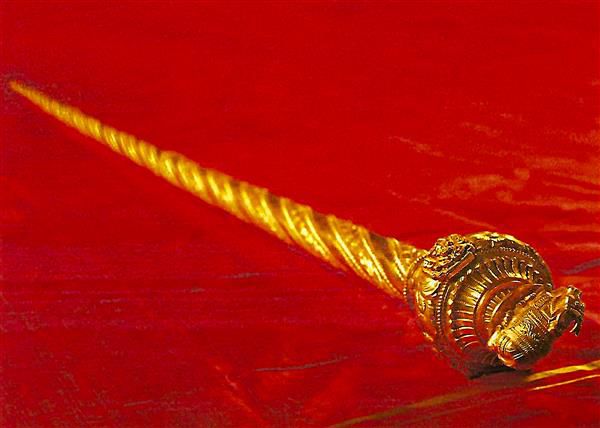Sengol controversy 2.0: Samajwadi Party MP calls historic sceptre 'anachronistic symbol of monarchy', wants it replaced with Constitution
Vibha Sharma
Chandigarh, June 27
When the Sengol was installed in the new Parliament building last year, there was a massive controversy over the historic sceptre, which began with the ruling BJP showcasing it as yet another “failure by first Prime Minister Jawaharlal Nehru to safeguard India’s history”.
Sengol is again at the centre of controversy, after Samajwadi Party MP RK Chaudhary called it an “anachronistic symbol of monarchy” and demanded it to be replaced with the Constitution in the Lok Sabha.
As expected, the demand invited backlash from BJP and NDA allies. However, according to observers, such issues are expected to “keep cropping up, especially with subdued strength of BJP in the 18th Lok Sabha”. If not Sengol, it will be something else, they add.
Sengol controversy 2.0
In his letter to the Lok Sabha Chair, Chaudhary called Sengol an “anachronistic symbol of monarchy” in a democratic India.
“Sengol means ‘Raj Dand’. It also means ‘Raja ka Danda’. After ending the princely order, the country became independent. Will the country be run by ‘Raja ka danda’ or the Constitution? I demand that Sengol be removed from Parliament to save the Constitution,” he said.
The BJP, in turn, accused the SP of insulting an integral part of Indian and Tamil culture. “If it was a symbol of monarchy, then why did the first Prime Minister Nehru accept it? Was he accepting that symbol and monarchy,” BJP spokesperson Shehzad Poonawalla was quoted as saying.
Meanwhile, SP chief Akhilesh Yadav defended his MP saying that he was only trying to point out that Prime Minister Narendra Modi did not bow before the Sengol after taking oath in the Lok Sabha.”
“When Sengol was installed, the Prime Minister had bowed to it. But he forgot to bow while taking the oath this time. I think our MP wanted to remind the Prime Minister about it,” Yadav was quoted as saying.
Senior Congress leader Manickam Tagore supported Samajwadi Party MP saying “we have been very clear that the ‘sengol’ symbolises kingship and the kingdom-era is over”. INDIA ally RJD MP Misa Bharti added “whosoever has demanded this, I welcome it.”
Sengol controversy 1.0
The controversy erupted over the way the journey/history of this particular Sengol was depicted—as “another one of Nehru’s failures to safeguard India’s history”.
The word Sengol first surfaced following “unofficial” reports in the media that a “historical and sacred” symbol received by India’s first Prime Minister Jawaharlal Nehru was lying unheard of in the Allahabad museum along with his other items and that it will be given its due place of pride in the new Parliament building on May 28.
According to the BJP leaders, “Lord Mountbatten asked Nehru how the reins of India be handed over, who subsequently asked Chakravarti Rajagopalachari, who said that it should be done in the way it was done centuries ago by south India’s Chera, Chola and Pandya dynasties. The suggestion was accepted and he was given the responsibility of making complete arrangements. The ceremony was organised before midnight and a special song was also sung when Nehru accepted the Sengol”.
Sceptics said there is not enough evidence to prove that while Congress termed the entire story “bogus” with senior leader Jairam Ramesh claiming “lack of documented evidence”.
“Is it any surprise that the new Parliament is being consecrated with typically false narratives from WhatsApp University?
“A majestic sceptre conceived of by a religious establishment in then Madras province and crafted in Madras city was indeed presented to Nehru in August 1947. However there is No documented evidence whatsoever of Lord Mountbatten, Rajaji & Nehru describing this sceptre as a symbol of transfer of British power to India. All claims to this effect are plain and simple — BOGUS,” Ramesh said.
His observations were met with strong objections from Home Minister Amit Shah who called it a “shameful insult”.
All about ‘Sengol’
Basically, it is a sceptre/staff/wand with a royal or imperial insignia signifying sovereign authority, justice, power and good governance, etc.
Sengol is the Tamil word for sceptre. A king’s dharma is to run the kingdom well and Sengol is the reminder of that dharma.
This particular Sengol “symbolised transfer of power from the British to India in 1947”.
It was placed next to the Chair of the Lok Sabha following a proper religious ceremony in which religious heads from across India participated.









